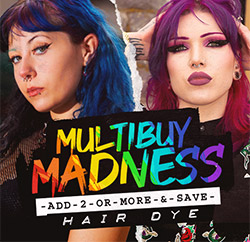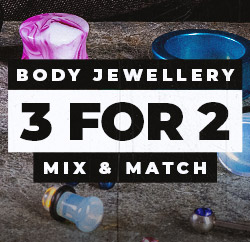- What is the Vagus Nerve?
- Vagus Nerve Stimulation (VNS) Treatments
- VNS & the Auricular Nerve Branch
- Blue Banana Medi-Daith & VNS
What is the Vagus Nerve?
The vagus nerve is present through nearly the entire body, branching out to vital organs such as the heart, lungs, and stomach. It is one of 12 pairs of cranial nerves that connect to the brain. It is the primary sensory nerve in the body that transmits data to the brain and from the brain to the body to regulate and control many different functions. This includes pain regulation, anxiety responses, fatigue, heart rate, digestion, and lung function.

Fig.1 The vagus nerve runs through the body and plays a part in controlling bodily functions.
Most importantly, the vagus nerve is directly linked with interoception; the sense that tells us information such as whether we are hungry, tired, in pain, etc. As a nerve that controls many senses and feelings, it's clear to see why it is targeted for treatments designed to regulate, prevent and control bodily responses.
When it comes to migraines or headaches, the vagus nerve is targeted as a means of reducing the severity of the body’s reaction to the discomfort a migraine can bring. The goal of stimulating the vagus nerve is to limit the body’s response and the pain felt by the migraine sufferer. Currently, known treatments such as Vagus Nerve Stimulation treatments typically focus on changing the pain signal to the brain.
Vagus Nerve Stimulation Information
Vagus Nerve Stimulation (VNS) is a widely-accepted treatment for migraine headaches. It uses electrical currents, commonly sent through a small hand-held device, for gentle stimulation of the vagus nerve. It is a non-invasive method that is widely preferred as patients do not need to rely on prescribed medication or injections for pain relief.
You’ll be able to find plenty of examples of different VNS devices that are used online. Most are smaller handheld products that can produce safe, yet effective, electrical pulses. Patients and users can apply the device themselves and, as you’ll see online, simply hold the device to the underside of their jawline.
In the US, VNS is an FDA-approved treatment for migraine and cluster headaches. VNS is also available in some UK locations as part of the NHS service. In the UK, it has been used most commonly for the treatment of epilepsy but has also been trialled for treating depression. Some centres use an implant rather than an external device to stimulate the Vagus Nerve in order to give more consistent stimulation to the vagus nerve.
Unlike medications such as pills, patients are able to use the VNS much more frequently without the danger of overdosing or having serious side effects. Patients can also be in full control of their treatment and apply it whenever required. While it cannot be used by people with heart conditions, it is a safer option for many. Testing is still ongoing for use during pregnancy but if it is viable, this will provide much-needed relief during times when other treatments are not suitable.
Because Vagus Nerve Stimulation is still an area that requires further study, the price point of VNS is usually quite high due to the equipment needed to carry it out. It is definitely an area of discovery where there are yet to be conclusive results or a definitive answer without further research. We’ve provided links below to some helpful resources you can find to see more about Vagus Nerve Stimulation as a treatment and how it is already present in the expanding world of vagus nerve research and understanding.
Vagus Nerve Stimulation Through the Auricular Nerve

Fig 2. The auricular brand of the vagus nerve is found beneath the skin surface of the ear canal.
There is already a growing body of medical literature on the benefits of using the auricular nerve area as a key area for stimulating response from the vagus nerve. The peer-reviewed paper Current Directions in the Auricular Vagus Nerve Stimulation II – An Engineering Perspective discusses the benefits of focusing the electrical current stimulation mentioned above on the area around the auricle area of the vagus nerve. It states: “The external ear is an ideal place for a non-invasive or minimally invasive stimulation of VN” (Kaniusas et. al, 2019, p. 2). They continue to describe the auricle “especially its aVPN endings as a potentially “powerful gateway to the brain”. (Kaniusas et. al, 2019, p. 2). As is evident here, the Vagus Nerve connects many of the most vital systems in the body: "Afferent auricular branches (aVN) leave the cervical VN at the level of the jugular ganglion just outside the cranium and innervate the rather central regions of the pinna of the outer ear." (Peuker and Filler, 2002). The site around the auricular is already a focal point of studies and is acknowledged as a location for vagus nerve stimulation and treatment.
Medi-Daith As A Form of Vagus Nerve Stimulation

The Medi-Daith piercing, available at Blue Banana, is a part of this body of research that is still discovering the effects of stimulating and piercing the vagus nerve. It sits alongside other efforts to try and work out ways to prevent the negative effects of debilitating illnesses such as chronic migraines and cluster headaches.
The Medi-Daith method takes vagus nerve stimulation one step further by piercing the area surrounding the auricular branch of the vagus nerve. It is thought that the healing process and presence of a piercing bar stimulate enough response within the vagus nerve to provide a more long-term effect. In other words, this method is more preventative rather than reactive and could provide a longer-term solution or continuous relief.
Usually, vagus nerve stimulation uses the neck where the vagus nerve is easy to find but with a precise tool, the Medi-Daith procedure locates the vagus nerve in the ear to give the client a classic daith piercing but with precise placement.
This method has been employed in Blue Banana stores across the UK with Blue Banana’s specialist piercers being trained in the method of Medi-Daith piercing by Dr Chris Blatchley of the London Migraine Clinic. These piercings are being offered as a part of a medical study into the effectiveness of Daith piercings as a means of relieving the discomfort of migraines. Dr Chris is leading the study and collecting data to measure the effectiveness of the procedure. The initial results are promising and show patients experiencing positive effects:
“58 of 90 (64%) described that overall their migraine headache symptoms were 75%-100% better, and 22 (27%) as 25-50% better. Only 8 (9%) said there had been no improvement.”
“5 of the 90 (72%) reported the migraine headache frequency was "much better", and these found that on average, the frequency of migraine headache days dropped 69% from 5.5 to 1.7 days/month.”
You can read the full initial research paper and keep up to date with the latest findings on the www.migraine-research.org website. If you too would like to take part in the Blue Banana research study then we invite you to arrange a callback with one of our store locations so you can speak to a Blue Banana Medi-Daith piercer. They will be able to help answer any questions and arrange an appointment for you.
Please see additional links and resources below.









